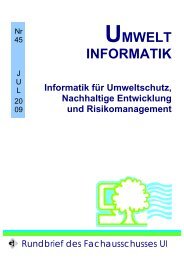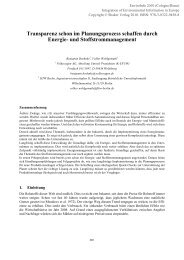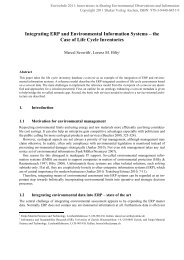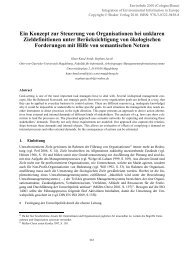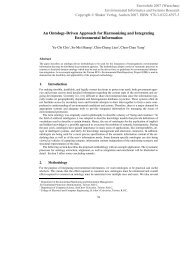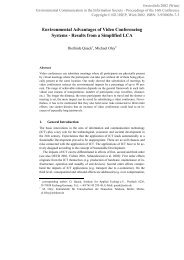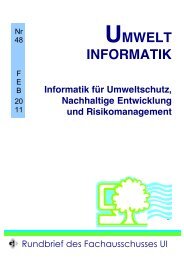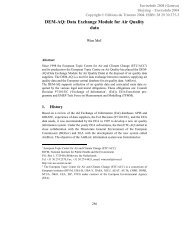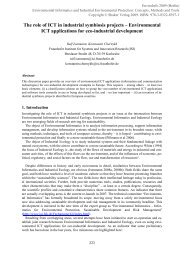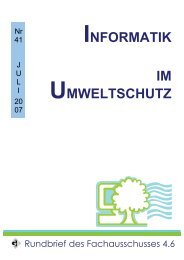Floating Car Data as Data Source for Modelling of Air ... - EnviroInfo
Floating Car Data as Data Source for Modelling of Air ... - EnviroInfo
Floating Car Data as Data Source for Modelling of Air ... - EnviroInfo
Create successful ePaper yourself
Turn your PDF publications into a flip-book with our unique Google optimized e-Paper software.
<strong>EnviroInfo</strong> 2002 (Wien)<br />
Environmental Communication in the In<strong>for</strong>mation Society - Proceedings <strong>of</strong> the 16th Conference<br />
Copyright © IGU/ISEP, Wien 2002. ISBN: 3-9500036-7-3<br />
<strong>Floating</strong> <strong>Car</strong> <strong>Data</strong> <strong>as</strong> <strong>Data</strong> <strong>Source</strong> <strong>for</strong> <strong>Modelling</strong> <strong>of</strong><br />
<strong>Air</strong> and Noise Pollution in Regions with High Traffic<br />
Density<br />
Bernhard Nowotny 1 , Peter Maurer 2 , Katja Schechtner 1 , Wilfried<br />
Winiwarter 3 , Jürgen Zajicek 1<br />
Abstract<br />
As air and noise pollution models depend on real-time traffic data, the integration <strong>of</strong> traffic<br />
in<strong>for</strong>mation (air and noise emissions) h<strong>as</strong> been recognised <strong>as</strong> an important step in urban<br />
are<strong>as</strong>. As the equipment <strong>of</strong> fixed me<strong>as</strong>urement stations <strong>for</strong> traffic, air pollution and<br />
noise detection is limited by financial constraints in<strong>for</strong>mation from cars equipped with<br />
sensors (<strong>Floating</strong> <strong>Car</strong>s) supplements in<strong>for</strong>mation from these sources. The position and<br />
the speed <strong>of</strong> cars are acquired by satellite navigation in combination with mobile communication,<br />
cellular phone tracking systems and long wave positioning. Further knowledge<br />
<strong>of</strong> the relation among traffic-related parameters is used to estimate traffic flow in<br />
the road network. B<strong>as</strong>ed on the estimations available models <strong>for</strong> traffic-related air and<br />
noise emissions can be applied to calculate emission inventories with an improved spatial<br />
and temporal resolution. So the development <strong>of</strong> methods <strong>for</strong> the detection, storage<br />
and interpretation <strong>of</strong> <strong>Floating</strong> <strong>Car</strong> data h<strong>as</strong> the potential <strong>of</strong> improving the in<strong>for</strong>mation<br />
b<strong>as</strong>is <strong>for</strong> modelling <strong>of</strong> the traffic situation, air and noise pollution in regions with high<br />
traffic density.<br />
1. Objectives<br />
The state <strong>of</strong> the environment is normally <strong>as</strong>sessed by environmental monitoring systems<br />
(e.g. air pollution monitoring, noise monitoring, water pollution monitoring).<br />
Logistic <strong>as</strong> well <strong>as</strong> financial limitations reduce the amount <strong>of</strong> actually available in<strong>for</strong>mation<br />
to a number <strong>of</strong> sites that are then considered representative. Different<br />
modelling approaches have been developed to estimate the spatial distribution within<br />
1 arsenal research, Business Area Transport Technologies, Faradayg<strong>as</strong>se 3, A-1030 Wien,<br />
email: bernhard.nowotny@arsenal.ac.at , http://www.arsenal.ac.at<br />
2 arsenal research, Business Area Transport Routes Engineering, Faradayg<strong>as</strong>se 3, A-1030<br />
Wien, email: peter.maurer@arsenal.ac.at , http://www.arsenal.ac.at<br />
3 ARC Seibersdorf research GmbH, Systems Research Division, A-2444 Seibersdorf, email:<br />
wilfried.winiwarter@arcs.ac.at , http://www.arcs.ac.at
660<br />
the investigated area [e.g. Loibl et al., 1994]. As emissions <strong>of</strong> noise and atmospheric<br />
pollutants from the transport sector may considerably effect the environment, frequently<br />
the emissions from this sector constitute an input to such models. Emissions<br />
from transport <strong>of</strong> p<strong>as</strong>sengers or goods are known to vary according to a number <strong>of</strong><br />
traffic-related parameters such <strong>as</strong> traffic flow, speed, weather situation and specific<br />
vehicle properties (e.g. vehicle type, hub load). Currently many emission models are<br />
b<strong>as</strong>ed on statistical or historical data (e.g. vehicle licences per area and average driving<br />
time, historical time series <strong>of</strong> traffic flow) so that the modelling domain is covered<br />
in part only, which consequently leads to rather high uncertainty.<br />
The in<strong>for</strong>mation derived from <strong>Floating</strong> <strong>Car</strong> <strong>Data</strong> (FCD) h<strong>as</strong> already been recognised<br />
<strong>as</strong> an important source <strong>for</strong> traffic related in<strong>for</strong>mation (mainly speed, calculation<br />
<strong>of</strong> travel time). FCD technology h<strong>as</strong> the potential to deliver near real-time data<br />
which can be applied <strong>for</strong> traffic control me<strong>as</strong>ures <strong>as</strong> e.g. line management on motorways,<br />
line control systems, generation <strong>of</strong> traffic messages <strong>for</strong> drivers and other traffic<br />
participants [RHAPIT, 1995 and EUROSCOPE / FOCUS, 1999].<br />
The aim <strong>of</strong> this paper is to demonstrate how existing FCD can be applied to <strong>as</strong>sess<br />
the parameters required <strong>for</strong> traffic related environmental modelling. While no results<br />
from emission modelling are available at this stage, we can demonstrate which approaches<br />
are ready <strong>for</strong> application. Thus the described method is a further step towards<br />
integration <strong>of</strong> transport and environmental monitoring [see EEA, 2001].<br />
2. Detecting <strong>Floating</strong> <strong>Car</strong> <strong>Data</strong> and Generating Traffic In<strong>for</strong>mation<br />
The idea <strong>of</strong> using <strong>Floating</strong> <strong>Car</strong> <strong>Data</strong> (FCD) to collect traffic data could initiate a decisive<br />
change in traffic monitoring. This method uses sensors integrated in vehicles<br />
to collect data mainly <strong>of</strong> position and speed, but also additional parameters (steering<br />
wheel angle, road slope, etc.). The metered values are sent to a traffic in<strong>for</strong>mation<br />
sub-center with the help <strong>of</strong> the navigation unit via satellite or via GSM- or GPRS<br />
mobile phones.<br />
There are three ways to locate a vehicle:<br />
1) Satellite navigation (GPS/EGNOS/GALILEO) in combination with<br />
GSM/GPRS/UMTS data transfer<br />
Satellite navigation systems have already been implemented <strong>for</strong> commercial systems<br />
<strong>of</strong> haulage companies and other vehicle fleets (e.g. taxicabs). A wider application <strong>for</strong><br />
the generation <strong>of</strong> traffic in<strong>for</strong>mation h<strong>as</strong> been tested in several pilot trials in European<br />
cities [c.f. Offermann, 2001, EUROSCOPE / FOCUS, 1999], but few systems<br />
evolved beyond the test ph<strong>as</strong>e [e.g. RHAPIT, 1995]. The re<strong>as</strong>ons <strong>for</strong> not entering a<br />
commercial ph<strong>as</strong>e were rather organisational than technical obstacles (e.g. missing<br />
business c<strong>as</strong>es or agreements in <strong>for</strong>m <strong>of</strong> public-private partnerships).<br />
29.08.02, 9202 EI P 074 I2 NowotnyB.doc<br />
Copyright © IGU/ISEP, Wien 2002. ISBN: 3-9500036-7-3
661<br />
The in<strong>for</strong>mation supplied by satellite navigation systems are geographical coordinates<br />
and direction <strong>of</strong> the vehicle. The precision <strong>of</strong> location in<strong>for</strong>mation depends<br />
on the satellite navigation system used (currently only GPS is available, EGNOS and<br />
GALILEO are still in development).<br />
2) Cellular Phone tracking systems <strong>as</strong> systems used to run Location B<strong>as</strong>ed Services<br />
(LBS)<br />
Another method to collect mobility data is “tracking” <strong>of</strong> mobile phones. The mobile<br />
phones are called from an in<strong>for</strong>mation center via a special code, which requests the<br />
SIM-card <strong>of</strong> the mobile phone to send back an SMS with the number <strong>of</strong> the currently<br />
used radio cell. This cell-ID is linked to the co-ordinates <strong>of</strong> the b<strong>as</strong>e station and supplies<br />
relatively precise in<strong>for</strong>mation about the current position <strong>of</strong> the mobile phone<br />
depending on the size <strong>of</strong> the radio cell (several hundred meters in urban regions).<br />
This position data is collected in fixed time steps. In a similar way <strong>as</strong> by GPS, the<br />
travel times in a region can be metered by tracing some mobile phones. Traffic in<strong>for</strong>mation<br />
<strong>of</strong> the current position <strong>of</strong> the tracked mobile phones is generated by comparing<br />
historic travel time data with the current travel times.<br />
3) Long wave positioning using hyperbolic navigation methods<br />
A combination <strong>of</strong> long wave positioning and satellite navigation reduces the shadowing<br />
and reflection effects (urban canyoning) in urban regions (e.g. DATATRAK system).<br />
Additionally a dGPS-signal is modulated onto the long wave to revise a noisy<br />
signal to get a more exact position value.<br />
A realistic image <strong>of</strong> the current traffic situation can only be produced with a<br />
minimum <strong>of</strong> pursuant-equipped vehicles in the investigated road network. The proportion<br />
<strong>of</strong> floating cars in the whole vehicle fleet depends on the purpose and the<br />
security <strong>of</strong> the result. The recognition <strong>of</strong> a traffic jam demands a smaller proportion<br />
than the calculation <strong>of</strong> an exact average velocity. If a generated traffic message h<strong>as</strong><br />
to be confirmed by more than one vehicle on the same road segment the proportion<br />
(and the correlated probability <strong>of</strong> a p<strong>as</strong>sing vehicle) h<strong>as</strong> to be higher. A pilot trial in<br />
the Rhine/Main Region [RHAPIT, 1995] states that 2 to 3 % <strong>of</strong> traffic volume is<br />
necessary <strong>for</strong> f<strong>as</strong>t and reliable detection <strong>of</strong> a traffic disruption. Due to the currently<br />
low level <strong>of</strong> pursuant-equipped vehicles this traffic data metering method will only<br />
be applicable in a few years. The current architecture <strong>of</strong> a Traffic In<strong>for</strong>mation Center<br />
(TIC) should consider the implementation <strong>of</strong> new interfaces and algorithms to be<br />
able to use in<strong>for</strong>mation from FCD technologies.<br />
The individual position values arriving from the <strong>Floating</strong> <strong>Car</strong>s have to be allocated<br />
to a virtual metering station in a digital road map stored in a Geographic In<strong>for</strong>mation<br />
System (GIS) be<strong>for</strong>e the integration <strong>of</strong> FCD into a traffic simulation.<br />
Unlike <strong>for</strong> stationary metering stations, which collect data <strong>for</strong> fixed road sections,<br />
there is the possibility to generate “dummy metering stations” with any desired distance<br />
in between according to the “traffic sensitivity” <strong>of</strong> the road section. This per-<br />
29.08.02, 9202 EI P 074 I2 NowotnyB.doc<br />
Copyright © IGU/ISEP, Wien 2002. ISBN: 3-9500036-7-3
662<br />
mits a more differentiated view on the current traffic situation. Furthermore the network<br />
<strong>of</strong> expensive fixed traffic count devices (loop detectors) can be reduced to a<br />
minimum which may be necessary <strong>for</strong> reference purposes.<br />
As the availability <strong>of</strong> FCD depends on the presence <strong>of</strong> specially equipped vehicles<br />
a fe<strong>as</strong>ible vehicle flow will first be reached in urban are<strong>as</strong> where<strong>as</strong> little in<strong>for</strong>mation<br />
will be available in rural are<strong>as</strong>. As most environmental problems related to transport<br />
occur in urban are<strong>as</strong> or along routes with high traffic flow (e.g. congestion, peaks <strong>of</strong><br />
air pollution, high noise emissions) the method delivers data precisely where it is<br />
most urgently needed.<br />
For the calculation <strong>of</strong> emissions from the transport sector an estimation <strong>of</strong> traffic<br />
flow on a specified road segment h<strong>as</strong> to be available. As FCD mainly deliver position<br />
and speed <strong>of</strong> vehicles the parameter traffic flow on a certain road segment h<strong>as</strong> to<br />
be estimated from further in<strong>for</strong>mation on the road segment (e.g. number <strong>of</strong> lanes,<br />
traffic light ph<strong>as</strong>es and development <strong>of</strong> <strong>as</strong>sociated waiting queue, historical and realtime<br />
data from detectors) and speed. As the vehicle fleet equipped <strong>for</strong> transmitting<br />
<strong>Floating</strong> <strong>Car</strong> <strong>Data</strong> is only a representative sample <strong>for</strong> the whole vehicle fleet the exact<br />
traffic flow and vehicle cl<strong>as</strong>sification will still require the use <strong>of</strong> appropriate loop<br />
detectors.<br />
3. Generating In<strong>for</strong>mation from <strong>Floating</strong> <strong>Car</strong> <strong>Data</strong> <strong>for</strong> Status and<br />
Impact <strong>of</strong> Transport Related Activities<br />
3.1 Atmospheric pollutants<br />
Current approaches to estimate emissions from road traffic all combine an emission<br />
factor with available in<strong>for</strong>mation on vehicle mileage [Ntziachristos and Samar<strong>as</strong>,<br />
2000]. This very simple approach is complicated by the necessity to separate different<br />
vehicle types and vehicle concepts (e.g. Diesel vs. g<strong>as</strong>oline driven cars, with or<br />
without catalytic converter). Emission factors are also available <strong>for</strong> different driving<br />
conditions, ranging from stop-and-go traffic to highway speed traffic. Now the vehicle<br />
fleet may be determined from car registration numbers, or from occ<strong>as</strong>ional <strong>as</strong><br />
well <strong>as</strong> from continuous traffic counts (loop detectors). Also, vehicle mileage <strong>as</strong> well<br />
<strong>as</strong> temporal distribution <strong>of</strong> emissions may be estimated from such traffic counts.<br />
However, especially in cities the number <strong>of</strong> traffic count sites is relatively small in<br />
respect to total mileage and requires the use <strong>of</strong> outputs from sophisticated traffic<br />
models, if at all available. Additionally, speed distribution is very difficult to <strong>as</strong>sess.<br />
Vehicle speed is not only required to apply the correct emission factor, but even the<br />
ratio between different pollutants. Emissions <strong>of</strong> Nitrogen oxides (NO x ) tend to be<br />
higher at higher motor temperatures and speeds, compounds emitted due to incomplete<br />
combustion (carbon monoxide (CO) and volatile organic compounds (VOC))<br />
tend to be extremely high during stop-and-go traffic.<br />
29.08.02, 9202 EI P 074 I2 NowotnyB.doc<br />
Copyright © IGU/ISEP, Wien 2002. ISBN: 3-9500036-7-3
663<br />
<strong>Floating</strong> car data deliver in<strong>for</strong>mation on speed <strong>of</strong> vehicles and general traffic<br />
situation. With the help <strong>of</strong> traffic modelling s<strong>of</strong>tware, historical data and a small<br />
number <strong>of</strong> real-time data from me<strong>as</strong>urement points can be used to estimate traffic<br />
flow and total mileage throughout such a model area at an adequate temporal resolution.<br />
Emissions even may be <strong>as</strong>sessed real-time, a feature that is uncommon in standard<br />
emission inventories. Furthermore, the emission in<strong>for</strong>mation can be used <strong>as</strong> input<br />
to photochemical models. As the chemical regime within city centres is generally<br />
VOC limited in terms <strong>of</strong> ozone <strong>for</strong>mation (i.e. further VOC emissions will be critical<br />
<strong>for</strong> further photochemical activity – [see Prevot et al., 1997]) additional in<strong>for</strong>mation<br />
on the stop-and-go traffic will help to strongly incre<strong>as</strong>e reliability <strong>of</strong> emission inventories<br />
used <strong>for</strong> atmospheric modelling or even atmospheric air quality <strong>for</strong>ec<strong>as</strong>ts.<br />
3.2 Traffic-related Noise<br />
The main factors <strong>for</strong> the detection <strong>of</strong> noise emissions from transport are traffic load<br />
and composition (fraction <strong>of</strong> heavy duty vehicles), vehicle speed, road surface, road<br />
gradient and equipment <strong>as</strong> e.g. traffic lights. Traffic noise exposure can be calculated<br />
by appropriate models taking into account these parameters. Additional factors on<br />
noise generation are the distance <strong>of</strong> the receptor point from the roadway, height<br />
above road surface and street or ground morphology, obstacles (e.g. houses) and meteorological<br />
impacts.<br />
<strong>Floating</strong> car data deliver in<strong>for</strong>mation on speed <strong>of</strong> vehicles and general traffic<br />
situation. With the help <strong>of</strong> traffic modelling s<strong>of</strong>tware, historical data and a small<br />
number <strong>of</strong> real-time data from me<strong>as</strong>urement points can be used to estimate traffic<br />
load. This <strong>for</strong>ms the b<strong>as</strong>is <strong>for</strong> calculation <strong>of</strong> noise emissions where no exact me<strong>as</strong>urements<br />
are available.<br />
3.3 Integration <strong>of</strong> models into simulation s<strong>of</strong>tware<br />
The <strong>Floating</strong> <strong>Car</strong> <strong>Data</strong> method delivers b<strong>as</strong>ic dynamic in<strong>for</strong>mation <strong>of</strong> the current<br />
traffic situation at different points <strong>of</strong> times. This method presupposes simulation<br />
tools using variable time steps instead <strong>of</strong> constant time steps like the programs <strong>of</strong>fered<br />
today. Only online simulation can evaluate traffic data sent by moving vehicles<br />
at different times and positions.<br />
The air pollution model operating at ARC Seibersdorf calculates emissions with<br />
time steps <strong>of</strong> about one hour. There<strong>for</strong>e the results <strong>of</strong> an online traffic simulation<br />
have to be aggregated to the time steps used in the air pollution model in an interface<br />
s<strong>of</strong>tware. An open architecture <strong>of</strong> this interface between simulation and pollution<br />
models will <strong>as</strong>sure that changing or new parameters <strong>of</strong> the air pollution model (time<br />
steps, ...) can be considered without any technical ef<strong>for</strong>t.<br />
29.08.02, 9202 EI P 074 I2 NowotnyB.doc<br />
Copyright © IGU/ISEP, Wien 2002. ISBN: 3-9500036-7-3
664<br />
4. Conclusions<br />
As air and noise pollution models depend on real-time traffic data the integration <strong>of</strong><br />
traffic in<strong>for</strong>mation with in<strong>for</strong>mation on air and noise emissions h<strong>as</strong> been recognised<br />
<strong>as</strong> an important step in urban are<strong>as</strong> [see HEAVEN, 2001]. Similar to air pollution the<br />
implementation <strong>of</strong> the planned Directive on the Assessment and Management <strong>of</strong> Environmental<br />
Noise will require the investigation <strong>of</strong> the noise situation in urban are<strong>as</strong><br />
[see CALM network, 2002]. As the equipment <strong>of</strong> fixed me<strong>as</strong>urement stations <strong>for</strong><br />
traffic, air pollution and noise detection is limited by financial constraints the application<br />
<strong>of</strong> in<strong>for</strong>mation from <strong>Floating</strong> <strong>Car</strong>s supplements the in<strong>for</strong>mation from these<br />
sources. So the development <strong>of</strong> methods <strong>for</strong> the detection, storage and interpretation<br />
<strong>of</strong> <strong>Floating</strong> <strong>Car</strong> data h<strong>as</strong> the potential <strong>of</strong> improving the in<strong>for</strong>mation b<strong>as</strong>is <strong>for</strong> modelling<br />
<strong>of</strong> traffic situation, air and noise pollution in regions with high traffic density.<br />
Bibliography<br />
CALM Community Noise Research Strategy Plan (2002): EU Commission, DG Research,<br />
GROWTH (5th FP), http://www.calm-network.com/index_start.htm<br />
EEA European Environment Agency (2001): Indicators tracking transport and environment<br />
integration in the European Union (TERM), 2001<br />
EUROSCOPE Efficient Urban Transport Operation Services Co-operation <strong>of</strong> Port Cities in<br />
Europe / subproject FOCUS (1999):, EU Directorate General XIII, Telematics Applications<br />
Programme, TAP - TR1023<br />
HEAVEN Healthier Environment through the Abatement <strong>of</strong> Vehicle Emissions and Noise<br />
(2001): EU Commission, IST Programme (5th FP), http://heaven.rec.org<br />
Loibl W., W. Winiwarter, A. Kopcsa, J. Zueger, R. Baumann (1994): Estimating the Spatial<br />
Distribution <strong>of</strong> Ozone Concentrations in Complex Terrain. Atmos Environ 28, 2557-<br />
2566.<br />
Ntziachristos L., Z. Samar<strong>as</strong> (2000): COPERT III. Computer programme to calculate emissions<br />
from road transport. Methodology and emission factors (Version 2.1). Technical<br />
report No 49. European Environment Agency, Copenhagen, DK<br />
Offermann F., Ein Neuro-Fuzzy-Modell zur Reisegeschwindigkeitsabschätzung auf Richtungs-Fahrbahnen<br />
b<strong>as</strong>ierend auf einer Fusion lokaler und fahrzeuggenerierter Verkehrsdaten,<br />
Dissertation an der Fakultät für Bauingenieurwesen der Rheinisch-<br />
Westfälischen Technischen Hochschule Aachen, Nov. 2001<br />
Prevot, A. S. H., J. Staehelin, G. L. Kok, R. D. Schillawski, B. Neininger, T. Staffelbach, A.<br />
Neftel, H. Wernli, and J. Dommen (1997): The Milan photooxidant plume. J. Geophys.<br />
Res., D102, 23375-23388.<br />
RHAPIT Rhein/Main Area Project <strong>for</strong> Integrated Traffic Project Definition (1995): EU Directorate<br />
General XIII, Programme DRIVE II - V2055<br />
29.08.02, 9202 EI P 074 I2 NowotnyB.doc<br />
Copyright © IGU/ISEP, Wien 2002. ISBN: 3-9500036-7-3






